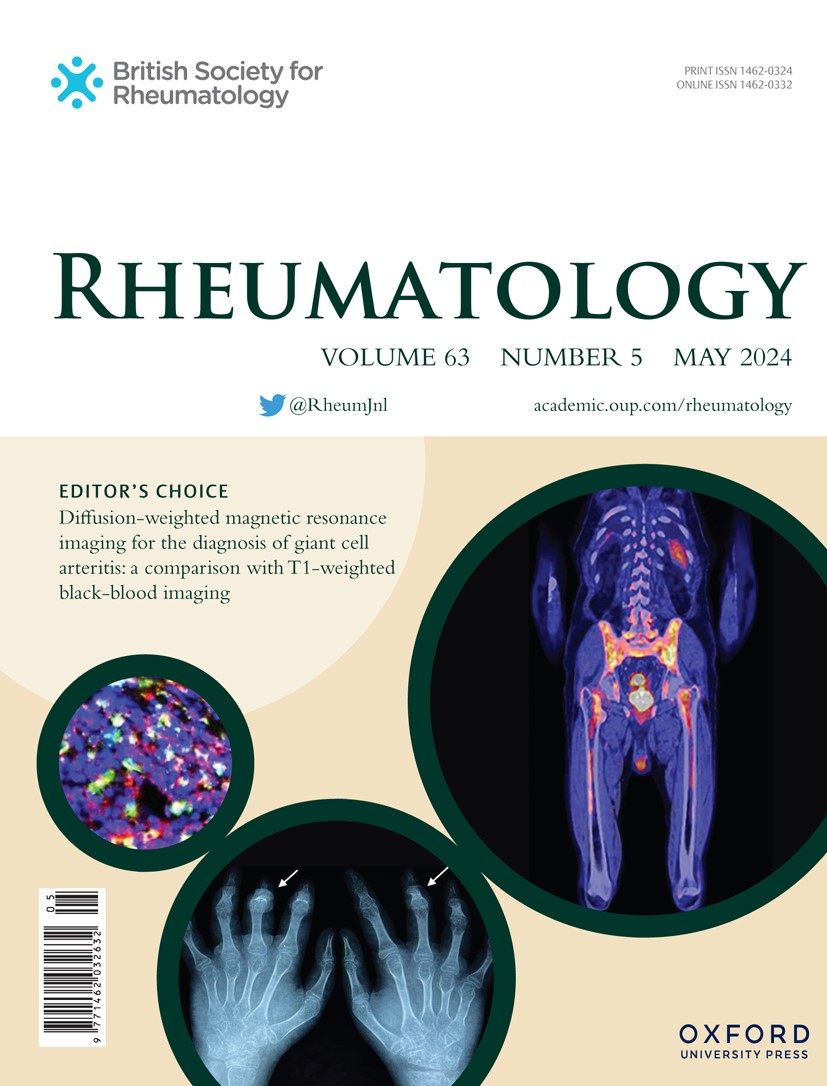Multi-domain effectiveness of guselkumab evaluated via composite indices through 1 year in patients with PsA and inadequate response to TNFi: post hoc analysis of COSMOS
IF 4.7
2区 医学
Q1 RHEUMATOLOGY
引用次数: 0
Abstract
Objective Evaluate guselkumab efficacy, an anti-interleukin-23p19-subunit antibody, in patients with active psoriatic arthritis (PsA) and inadequate response to 1–2 tumour necrosis factor inhibitors (TNFi-IR), utilizing composite indices assessing disease activity across disease domains. Methods In the Phase IIIb COSMOS trial, 285 adults with TNFi-IR PsA were randomized (2:1) to receive guselkumab 100 mg or placebo at Week (W)0, W4, then every 8 weeks through W44. Patients receiving placebo crossed over to guselkumab at W24. In this post-hoc analysis, composite indices evaluated included the Disease Activity Index for Psoriatic Arthritis (DAPSA), Disease Activity Score 28 (DAS28), Psoriatic Arthritis Response Criteria (PsARC), Psoriatic Arthritis Disease Activity Score (PASDAS), GRAPPA Composite score (GRACE), modified Composite Psoriatic Disease Activity Index (mCPDAI), minimal disease activity (MDA) and very low disease activity (VLDA). Through W24, treatment failure rules were applied. Through W48, non-responder imputation was used for missing data. Results Greater proportions of guselkumab- than placebo-randomized patients achieved composite index endpoints relating to low disease activity (LDA; 14.8–52.4% vs 3.1–28.1%) or remission (3.7–5.3% vs 0.0–2.1%) at W24. Among guselkumab-randomized patients, LDA rates increased to W48 (DAPSA, 44.4%; DAS28, 47.8%; PASDAS, 34.4%; GRACE, 33.3%; mCPDAI, 40.2%), and 27.0% and 64.0% achieved MDA and a PsARC response, respectively. In the placebo→guselkumab crossover group, W48 response rates were similar to the guselkumab-randomized group. Conclusion Guselkumab treatment provided substantial benefits across multiple disease domains, with increasing proportions of patients achieving LDA/remission over 1 year, highlighting the effectiveness of guselkumab despite previous inadequate response to TNFi.通过对 TNFi 反应不充分的 PsA 患者 1 年的综合指标评估古谢库单抗的多领域有效性:COSMOS 的事后分析
目的 评估抗白细胞介素-23p19亚基抗体古谢库单抗对活动性银屑病关节炎(PsA)患者的疗效,以及对1-2种肿瘤坏死因子抑制剂(TNFi-IR)反应不充分的患者的疗效,采用综合指数评估各疾病领域的疾病活动性。方法 在IIIb期COSMOS试验中,285名患有TNFi-IR PsA的成人患者被随机(2:1)分配在第0周和第4周接受100毫克的古谢库单抗或安慰剂治疗,然后在第44周之前每8周接受一次古谢库单抗或安慰剂治疗。接受安慰剂治疗的患者在第24周转为接受古舍库单抗治疗。在这项事后分析中,评估的综合指数包括银屑病关节炎疾病活动指数(DAPSA)、疾病活动评分28(DAS28)、银屑病关节炎应答标准(PsARC)、银屑病关节炎疾病活动评分(PASDAS)、GRAPPA综合评分(GRACE)、改良的银屑病疾病活动综合指数(mCPDAI)、最小疾病活动(MDA)和极小疾病活动(VLDA)。在 W24 期,采用治疗失败规则。至 W48,对缺失数据采用非应答者估算。结果 在W24时,达到低疾病活动度(LDA;14.8-52.4% vs 3.1-28.1%)或缓解(3.7-5.3% vs 0.0-2.1%)复合指标终点的古舍单抗随机患者比例高于安慰剂随机患者。在随机接受古舍库单抗治疗的患者中,LDA率上升至W48(DAPSA,44.4%;DAS28,47.8%;PASDAS,34.4%;GRACE,33.3%;mCPDAI,40.2%),分别有27.0%和64.0%的患者获得了MDA和PsARC应答。在安慰剂→古舍库单抗交叉组中,W48应答率与古舍库单抗随机组相似。结论 Guselkumab治疗在多个疾病领域均有显著疗效,1年内实现LDA/缓解的患者比例不断增加,这凸显了Guselkumab在既往对TNFi反应不充分的情况下的有效性。
本文章由计算机程序翻译,如有差异,请以英文原文为准。
求助全文
约1分钟内获得全文
求助全文
来源期刊

Rheumatology
医学-风湿病学
CiteScore
9.40
自引率
7.30%
发文量
1091
审稿时长
2 months
期刊介绍:
Rheumatology strives to support research and discovery by publishing the highest quality original scientific papers with a focus on basic, clinical and translational research. The journal’s subject areas cover a wide range of paediatric and adult rheumatological conditions from an international perspective. It is an official journal of the British Society for Rheumatology, published by Oxford University Press.
Rheumatology publishes original articles, reviews, editorials, guidelines, concise reports, meta-analyses, original case reports, clinical vignettes, letters and matters arising from published material. The journal takes pride in serving the global rheumatology community, with a focus on high societal impact in the form of podcasts, videos and extended social media presence, and utilizing metrics such as Altmetric. Keep up to date by following the journal on Twitter @RheumJnl.
 求助内容:
求助内容: 应助结果提醒方式:
应助结果提醒方式:


